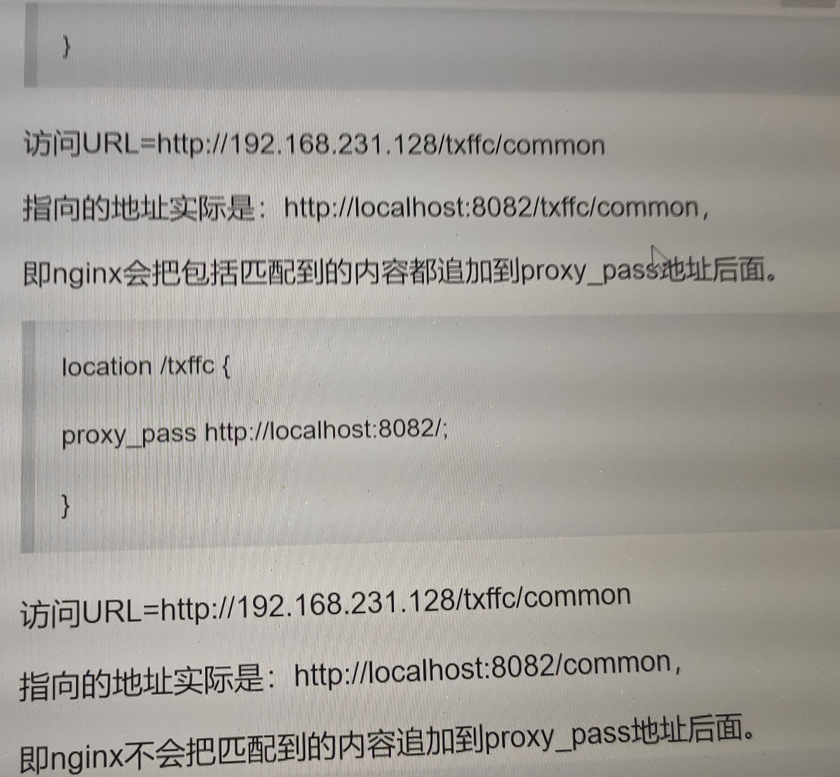Nginx配置文件
配置文件位置
/usr/local/nginx/conf/nginx.conf
配置文件主要由四部分组成:main(全区设置),server(主机配置),upstream(负载均衡服务器设置),和location(URL匹配特定位置设置)。
1)全局变量
#Nginx的worker进程运行用户以及用户组
#user nobody nobody;
#Nginx开启的进程数
worker_processes 1;
#worker_processes auto;
#以下参数指定了哪个cpu分配给哪个进程,一般来说不用特殊指定。如果一定要设的话,用0和1指定分配方式.
#这样设就是给1-4个进程分配单独的核来运行,出现第5个进程是就是随机分配了。eg:
#worker_processes 4 #4核CPU
#worker_cpu_affinity 0001 0010 0100 1000;
nets
#定义全局错误日志定义类型,[debug|info|notice|warn|crit]
#error_log logs/error.log info;
#指定进程ID存储文件位置
#pid logs/nginx.pid;
#一个nginx进程打开的最多文件描述符数目,理论值应该是最多打开文件数(ulimit -n)与nginx进程数相除,但是nginx分配请求并不是那么均匀,所以最好与ulimit -n的值保持一致。
#vim /etc/security/limits.conf
# * soft nproc 65535
# * hard nproc 65535
# * soft nofile 65535
# * hard nofile 65535
worker_rlimit_nofile 65535;
2)事件配置
events {
#use [ kqueue | rtsig | epoll | /dev/poll | select | poll ]; epoll模型是Linux 2.6以上版本内核中的高性能网络I/O模型,如果跑在FreeBSD上面,就用kqueue模型。
use epoll;
#每个进程可以处理的最大连接数,理论上每台nginx服务器的最大连接数为worker_processes*worker_connections。理论值:worker_rlimit_nofile/worker_processes
#注意:最大客户数也由系统的可用socket连接数限制(~ 64K),所以设置不切实际的高没什么好处
worker_connections 65535;
#worker工作方式:串行(一定程度降低负载,但服务器吞吐量大时,关闭使用并行方式)
#multi_accept on;
}
3)http参数
#文件扩展名与文件类型映射表
include mime.types;
#默认文件类型
default_type application/octet-stream;
#日志相关定义
#log_format main '$remote_addr - $remote_user [$time_local] "$request" '
# '$status $body_bytes_sent "$http_referer" '
# '"$http_user_agent" "$http_x_forwarded_for"';
#定义日志的格式。后面定义要输出的内容。
#1.$remote_addr 与$http_x_forwarded_for 用以记录客户端的ip地址;
#2.$remote_user :用来记录客户端用户名称;
#3.$time_local :用来记录访问时间与时区;
#4.$request :用来记录请求的url与http协议;
#5.$status :用来记录请求状态;
#6.$body_bytes_sent :记录发送给客户端文件主体内容大小;
#7.$http_referer :用来记录从那个页面链接访问过来的;
#8.$http_user_agent :记录客户端浏览器的相关信息
#连接日志的路径,指定的日志格式放在最后。
#access_log logs/access.log main;
#只记录更为严重的错误日志,减少IO压力
error_log logs/error.log crit;
#关闭日志
#access_log off;
#默认编码
#charset utf-8;
#服务器名字的hash表大小
server_names_hash_bucket_size 128;
#客户端请求单个文件的最大字节数
client_max_body_size 8m;
#指定来自客户端请求头的hearerbuffer大小
client_header_buffer_size 32k;
#指定客户端请求中较大的消息头的缓存最大数量和大小。
large_client_header_buffers 4 64k;
#开启高效传输模式。
sendfile on;
#防止网络阻塞
tcp_nopush on;
tcp_nodelay on;
#客户端连接超时时间,单位是秒
keepalive_timeout 60;
#客户端请求头读取超时时间
client_header_timeout 10;
#设置客户端请求主体读取超时时间
client_body_timeout 10;
#响应客户端超时时间
send_timeout 10;
#FastCGI相关参数是为了改善网站的性能:减少资源占用,提高访问速度。
fastcgi_connect_timeout 300;
fastcgi_send_timeout 300;
fastcgi_read_timeout 300;
fastcgi_buffer_size 64k;
fastcgi_buffers 4 64k;
fastcgi_busy_buffers_size 128k;
fastcgi_temp_file_write_size 128k;
#gzip模块设置
#开启gzip压缩输出
gzip on;
#最小压缩文件大小
gzip_min_length 1k;
#压缩缓冲区
gzip_buffers 4 16k;
#压缩版本(默认1.1,前端如果是squid2.5请使用1.0)
gzip_http_version 1.0;
#压缩等级 1-9 等级越高,压缩效果越好,节约宽带,但CPU消耗大
gzip_comp_level 2;
#压缩类型,默认就已经包含text/html,所以下面就不用再写了,写上去也不会有问题,但是会有一个warn。
gzip_types text/plain application/x-javascript text/css application/xml;
#前端缓存服务器缓存经过压缩的页面
gzip_vary on;
4)虚拟主机基本设置
#虚拟主机定义
server {
#监听端口
listen 80;
#访问域名
server_name localhost;
#编码格式,若网页格式与此不同,将被自动转码
#charset koi8-r;
#虚拟主机访问日志定义
#access_log logs/host.access.log main;
#对URL进行匹配
location / {
#访问路径,可相对也可绝对路径
root html;
#首页文件。以下按顺序匹配
index index.html index.htm;
}
#错误信息返回页面
#error_page 404 /404.html;
# redirect server error pages to the static page /50x.html
#
error_page 500 502 503 504 /50x.html;
location = /50x.html {
root html;
}
#访问URL以.php结尾则自动转交给127.0.0.1
# proxy the PHP scripts to Apache listening on 127.0.0.1:80
#
#location ~ .php$ {
# proxy_pass http://127.0.0.1;
#}
#php脚本请求全部转发给FastCGI处理
# pass the PHP scripts to FastCGI server listening on 127.0.0.1:9000
#
#location ~ .php$ {
# root html;
# fastcgi_pass 127.0.0.1:9000;
# fastcgi_index index.php;
# fastcgi_param SCRIPT_FILENAME /scripts$fastcgi_script_name;
# include fastcgi_params;
#}
#禁止访问.ht页面 (需ngx_http_access_module模块)
# deny access to .htaccess files, if Apache's document root
# concurs with nginx's one
#
#location ~ /.ht {
# deny all;
#}
}
#HTTPS虚拟主机定义
# HTTPS server
#
#server {
# listen 443 ssl;
# server_name localhost;
# ssl_certificate cert.pem;
# ssl_certificate_key cert.key;
# ssl_session_cache shared:SSL:1m;
# ssl_session_timeout 5m;
# ssl_ciphers HIGH:!aNULL:!MD5;
# ssl_prefer_server_ciphers on;
# location / {
# root html;
# index index.html index.htm;
# }
#}
#vue配置
server {
listen 80;
server_name jcsd-cdn-monitor.jdcloud.com;
#charset koi8-r;
#access_log logs/host.access.log main;
root /root/dist;
location / {
try_files $uri $uri/ /index.html;
}
error_page 500 502 503 504 /50x.html;
location = /50x.html {
root html;
}
}
5)Nignx状态监控
#Nginx运行状态,StubStatus模块获取Nginx自启动的工作状态(编译时要开启对应功能)
#location /NginxStatus {
# #启用StubStatus的工作访问状态
# stub_status on;
# #指定StubStaus模块的访问日志文件 可off
# access_log logs/Nginxstatus.log;
# #Nginx认证机制(需Apache的htpasswd命令生成)
# #auth_basic "NginxStatus";
# #用来认证的密码文件
# #auth_basic_user_file ../htpasswd;
#}
访问:http://IP/NginxStatus(测试就不加密码验证相关)
active connections – 活跃的连接数量
server accepts handled requests — 总共处理了3个连接 , 成功创建3次握手, 总共处理了1个请求
reading — 读取客户端的连接数.
writing — 响应数据到客户端的数量
waiting — 开启 keep-alive 的情况下,这个值等于 active – (reading+writing), 意思就是 Nginx 已经处理完正在等候下一次请求指令的驻留连接.
6)反向代理
#以下配置追加在HTTP的全局变量中
#启动代理缓存功能
proxy_buffering on;
#nginx跟后端服务器连接超时时间(代理连接超时)
proxy_connect_timeout 5;
#后端服务器数据回传时间(代理发送超时)
proxy_send_timeout 5;
#连接成功后,后端服务器响应时间(代理接收超时)
proxy_read_timeout 60;
#设置代理服务器(nginx)保存用户头信息的缓冲区大小
proxy_buffer_size 16k;
#proxy_buffers缓冲区,网页平均在32k以下的话,这样设置
proxy_buffers 4 32k;
#高负荷下缓冲大小(proxy_buffers*2)
proxy_busy_buffers_size 64k;
#设定缓存文件夹大小,大于这个值,将从upstream服务器传
proxy_temp_file_write_size 64k;
#反向代理缓存目录
proxy_cache_path /data/proxy/cache levels=1:2 keys_zone=cache_one:500m inactive=1d max_size=1g;
#levels=1:2 设置目录深度,第一层目录是1个字符,第2层是2个字符
#keys_zone:设置web缓存名称和内存缓存空间大小
#inactive:自动清除缓存文件时间。
#max_size:硬盘空间最大可使用值。
#指定临时缓存文件的存储路径(必须在同一分区)
proxy_temp_path /data/proxy/temp;
#服务配置
server {
#侦听的80端口
listen 80;
server_name localhost;
location / {
#反向代理缓存设置命令(proxy_cache zone|off,默认关闭所以要设置)
proxy_cache cache_one;
#对不同的状态码缓存不同时间
proxy_cache_valid 200 304 12h;
#设置以什么样参数获取缓存文件名
proxy_cache_key $host$uri$is_args$args;
#后端的Web服务器可以通过X-Forwarded-For获取用户真实IP
proxy_set_header Host $host;
proxy_set_header X-Real-IP $remote_addr;
proxy_set_header X-Forwarded-For $proxy_add_x_forwarded_for;
#代理设置
proxy_pass http://IP;
#文件过期时间控制
expires 1d;
}
#配置手动清楚缓存(实现此功能需第三方模块 ngx_cache_purge)
#http://www.123.com/2017/0316/17.html访问
#http://www.123.com/purge/2017/0316/17.html清楚URL缓存
location ~ /purge(/.*) {
allow 127.0.0.1;
deny all;
proxy_cache_purge cache_one $host$1$is_args$args;
}
#设置扩展名以.jsp、.php、.jspx结尾的动态应用程序不做缓存
location ~.*.(jsp|php|jspx)?$ {
proxy_set_header Host $host;
proxy_set_header X-Real-IP $remote_addr;
proxy_set_header X-Forwarded-For $proxy_add_x_forwarded_for;
proxy_pass http://IP;
}
7)负载均衡
#负载均衡服务器池
upstream my_server_pool {
#调度算法
#1.轮循(默认)(weight轮循权值)
#2.ip_hash:根据每个请求访问IP的hash结果分配。(会话保持)
#3.fair:根据后端服务器响应时间最短请求。(upstream_fair模块)
#4.url_hash:根据访问的url的hash结果分配。(需hash软件包)
#参数:
#down:表示不参与负载均衡
#backup:备份服务器
#max_fails:允许最大请求错误次数
#fail_timeout:请求失败后暂停服务时间。
server 192.168.1.109:80 weight=1 max_fails=2 fail_timeout=30;
server 192.168.1.108:80 weight=2 max_fails=2 fail_timeout=30;
}
#负载均衡调用
server {
...
location / {
proxy_pass http://my_server_pool;
}
}
8)URL重写
#根据不同的浏览器URL重写
if($http_user_agent ~ Firefox){
rewrite ^(.*)$ /firefox/$1 break;
}
if($http_user_agent ~ MSIE){
rewrite ^(.*)$ /msie/$1 break;
}
#实现域名跳转
location / {
rewrite ^/(.*)$ https://web8.example.com$1 permanent;
}
9)IP限制
#限制IP访问
location / {
deny 192.168.0.2;
allow 192.168.0.0/24;
allow 192.168.1.1;
deny all;
}1.配置静态资源
server { listen 80; server_name localhost; #charset koi8-r; #access_log logs/host.access.log main; #前端页面 location / { root /mnt/web; index index.html index.htm; } #静态资源 location /web/ { root /mnt/; autoindex on; }
#列表显示日志文件
location /logs {
alias /mnt;
autoindex on;
}
}
2.配置反向代理
server { listen 80; server_name localhost; #charset koi8-r; #access_log logs/host.access.log main; #服务端ip location /server/ { proxy_set_header Host $http_host; proxy_set_header X-Real-Ip $remote_addr; proxy_set_header REMOTE-HOST $remote_addr; proxy_set_header X-Forwarded-For $proxy_add_x_forwarded_for; proxy_pass http://192.168.100.253:80/; } }
3.配置负载均衡
upstream mina_lb { server 172.16.7.125:9001 weight=1 backup; server 172.16.7.125:9011 weight=1; } server { listen 80; server_name localhost; #charset koi8-r; #access_log logs/host.access.log main; location /minalb/ { proxy_pass http://mina_lb/; } }
4.配置重定向
server { listen 80; server_name www.xdgmt.com; return 301 https://www.xdgmt.com:445$request_uri; }
5.配置https
# HTTPS server # server { listen 443 ssl; server_name www.xdgmt.com; ssl_certificate /etc/nginx/conf/secret/cert.pem; #证书 ssl_certificate_key /etc/nginx/conf/secret/key.pem; #秘钥 ssl_session_cache shared:SSL:10m; ssl_session_timeout 10m; ssl_protocols TLSv1 TLSv1.1 TLSv1.2; ssl_ciphers ECDHE-RSA-AES128-GCM-SHA256:HIGH:!aNULL:!MD5:!RC4:!DHE; #加密算法 ssl_prefer_server_ciphers on; #配置相关静态资源参数,优化访问静态资源文件 # 车辆图片访问路径 location /mina/cars/ { expires 96h; root /mnt/LINCHR/all_images/; autoindex off; } }
5.配置tcp协议模块(需要nginx版本在1.9以上,不能配置在http模块内 )
stream { upstream socket_proxy { hash $remote_addr consistent; server 192.168.100.253:9190 weight=5 max_fails=3 fail_timeout=30s; } # TCP协议 server { listen 9190; proxy_connect_timeout 1s; proxy_timeout 3s; proxy_pass socket_proxy; } }
nginx在反向代理的时候,proxy_pass需要指定路径,有无"/"的区别,如下:
